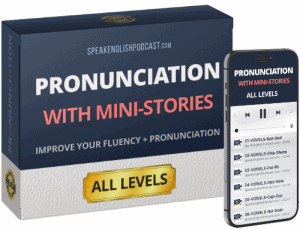
Get my Pronunciation Course!
Transcript:
Hi! I’m Georgiana, and I’m back with a new episode of the Speak English Now podcast—the podcast that helps you speak English fluently, with no grammar and no textbooks.
This is the third episode in our pronunciation series. In the first episode, we practiced R and L. In the second one, we worked on the TH sound. And today, we’ll practice the difference between V and B.
These sounds can be very tricky, because in some languages there isn’t much difference between them. But in English, they are very different.
So today, we’ll warm up with some minimal pairs, then practice with simple sentences, and finally we’ll do a mini-story.
Quick Word-Pair Drills (listen & repeat)
vest – best
vow – bow
vote – boat
vending – bending
van – ban
vet – bet
very – berry
vase – base
vent – bent
Viking – biking
Word Pairs in Sentences
vest – best
This is the best vest.
van – ban
The van is parked near the ban sign.
vet – bet
The vet made a bet on the horse race.
very – berry
That berry looks very fresh.
vase – base
The vase fell off the base.
vow – bow
They bow when they make a vow.
vote – boat
We vote before we get on the boat.
vending – bending
The vending machine was bending under the weight.
vent – bent
The vent was bent after the storm.
Viking – biking
The Viking went biking near the coast.
Tongue Twister Practice (V and B)
Repeat slowly after me. Then try to go faster and faster.
- Vivian visited a village.
- Ben bought big blue balloons.
- Very big berries.
- Vivian’s velvet vest vanished.
- Bob’s van was very bright.
- Victor’s violin vibrated very badly.
If you want to practice more, get my
Pronunciation Course
Mini-Story
(Practice Speaking)
I’ll tell you a short story, then I’ll ask you questions. After each question, you’ll answer out loud. Then I’ll confirm the correct answer. This helps you think in English and improve your speaking.
Let’s start!
Victor went to a café. He wanted to order a berry juice.
Who went to a café?
Victor. Victor went to a café.
What did Victor want to order?
A berry juice. He wanted to order a berry juice.
Did Victor want a berry juice or an orange juice?
A berry juice. He wanted a berry juice.
But Victor pronounced it wrong. Instead of “berry,” he said “very.”
Did Victor pronounce “berry” correctly?
No. He didn’t pronounce it correctly.
What did he say instead of berry?
Very. He said very.
Did he want very juice or berry juice?
Berry juice. He wanted berry juice.
The waiter looked confused. He asked, “Very juice? What is very juice?”
Did the waiter understand Victor?
No. The waiter didn’t understand.
Why didn’t the waiter understand?
Because Victor said “very” instead of “berry.”
What strange thing did the waiter ask?
He asked, “What is very juice?”
Victor laughed and repeated slowly, “Berry juice, please. I want berry juice.”
Did Victor get angry or laugh?
He laughed. Victor laughed.
Did he repeat quickly or slowly?
Slowly. He repeated slowly.
What did he finally say correctly?
Berry juice. He said berry juice correctly.
The waiter nodded, but he still wasn’t sure. He asked, “Blueberry juice or strawberry juice?”
Did the waiter ask about blueberry juice or apple juice?
Blueberry juice. He asked about blueberry juice.
Did he also ask about strawberry juice?
Yes. He also asked about strawberry juice.
Why did the waiter ask again?
Because he was still confused. He was still confused.
Victor pointed to the menu and said, “Strawberry. I want strawberry juice.”
Did Victor point to the menu or the door?
The menu. He pointed to the menu.
What juice did Victor finally choose—blueberry or strawberry?
Strawberry. He chose strawberry juice.
Did he say it correctly this time?
Yes. He said it correctly.
The waiter finally understood and brought him a big glass of strawberry juice.
Did the waiter finally understand?
Yes. He finally understood.
What did the waiter bring—water or strawberry juice?
Strawberry juice. He brought strawberry juice.
Was it a small glass or a big glass?
A big glass. He brought a big glass of strawberry juice.
Victor smiled and thought, “Next time, I’ll practice my V and B sounds before I order.”
What did Victor do at the end—smile or cry?
Smile. He smiled.
What sounds did he want to practice—V and B or R and L?
V and B. He wanted to practice V and B.
When did he want to practice them—before or after ordering?
Before. He wanted to practice before ordering.
Great job! Today you practiced the difference between V and B with minimal pairs, example sentences, tongue twisters, and a mini-story.
Remember:
- For the V sound, touch your top teeth gently on your bottom lip and let the air vibrate.
- For the B sound, close your lips completely, then release the air.
Practice slowly every day. Clarity comes first, speed comes later.
This was the third episode in our pronunciation series. In the next one, we’ll practice SH and CH—like ship and chip.
See you in the next episode!
If you want to practice more, get my
Pronunciation Course

Get my Pronunciation Course!
0 Comments